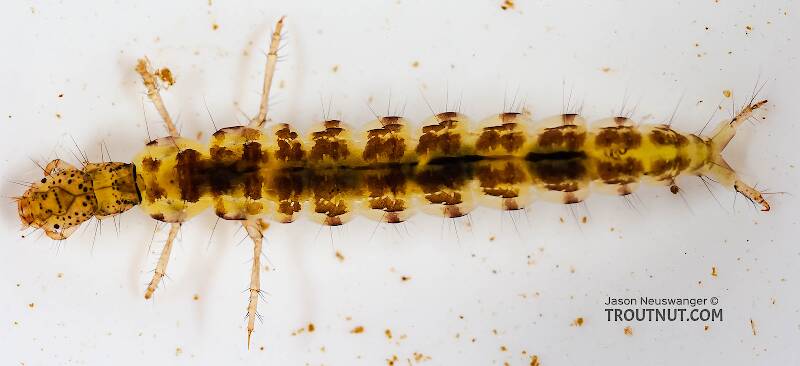
Blue-winged Olives
Baetis
Tiny Baetis mayflies are perhaps the most commonly encountered and imitated by anglers on all American trout streams due to their great abundance, widespread distribution, and trout-friendly emergence habits.
Featured on the forum

This one was surprisingly straightforward to identify. The lack of a sclerite at the base of the lateral hump narrows the field quite a bit, and the other options followed fairly obvious characteristics to Clostoeca, which only has one species, Clostoeca disjuncta.

Troutnut is a project started in 2003 by salmonid ecologist Jason "Troutnut" Neuswanger to help anglers and
fly tyers unabashedly embrace the entomological side of the sport. Learn more about Troutnut or
support the project for an enhanced experience here.
Identification: Key to Genera of Polycentropodidae Larvae, Couplet 4
Identification: Key to Genera of Polycentropodidae Larvae, Couplet 4
Error: Tried to access a key that isn't live.
Adapted from Merritt R.W., Cummins, K.W., and Berg, M.B. (2019)
This couplet refers figures (usually designated 'sf') from this source.
You will need the source (make sure to get the same edition!) to see them.
This couplet refers figures (usually designated 'sf') from this source.
You will need the source (make sure to get the same edition!) to see them.
| Option 1 | Option 2 |
|---|---|
| Dorsal region between anal claw and sclerite of distal segment of each anal proleg with 2 dark bands contiguous mesally (sf 19.392 inset) | Dorsal region between anal claw and sclerite of distal segment of each anal proleg with 2 dark bands completely separated mesally (sf 19.393 inset) |
| Mesonotal sa1 and metanotal sa1 setae short, not more than 1/3 as long as longest sa2 setae (sf 19.397) | Mesonotal sa1 and metanotal sa1 setae about as long as longest sa2 setae (sf 19.398) |
| Silken retreat similar to that of Nyctiophylax, but more nearly circular Central, East | |
| Remaining genera: Cernotina, Holocentropus, Plectrocnemia, and Polycentropus | |
2 Example Specimens | |
| Go to Couplet 5 | Cyrnellus Species Cyrnellus fraternus No further information about this genus is available on Troutnut.com at this time. |
Adapted from Merritt R.W., Cummins, K.W., and Berg, M.B. (2019)
The current couplet is highlighted with darker colors and a icon, and couplets leading to this point have a icon.
Leads to Couplet 2:
- Anal claws each with 6 or fewer conspicuous teeth along ventral, concave margin (sf 19.387, 19.388)
- Silken retreat forming rectangular tent over depression in wood or rock, open at two ends
Couplet 2
Leads to Couplet 3:
- Anal claws without ventral teeth (sf 19.389, 19.390, 19.392, 19.393) or each with 10 or more tiny spines (sf 19.391) along ventral, concave margin
Couplet 3
Leads to Nyctiophylax:
- Teeth on anal claw much shorter than apical hook, dorsal accessory spine present (sf 19.65, 19.388)
- Pronotum with short, stout bristle near each lateral margin (sf 19.394)
- Widespread except not Southwest
Leads to Polyplectropus:
- Teeth on each anal claw almost as long as apical hook, dorsal accessory spine absent (sf 19.387)
- Pronotum without short, lateral bristles
- Southwest
Polyplectropus
Leads to Neureclipsis:
- Basal segment of each anal proleg about as long as distal segment and with only 2 or 3 apicoventral setae (sf 19.391)
- Anal claw with many tiny spines along ventral, concave margin (sf 19.391 inset)
- Larvae as in sf 10.167 Silken retreat trumpet-shaped, recurved, up to 12 cm long, slender basally and broad apically, with 3–4 cm opening facing current (sf 19.37) Widespread except not Southwest
Leads to Couplet 4:
- Basal segment of each anal proleg obviously longer than distal segment in mature specimens and with many setae scattered over most of its ventral and dorsal surfaces (sf 19.392, 19.393)
- Anal claw without tiny ventral spines (sf 19.392, 19.393)
Couplet 4
Couplet 4 (You are here)
Leads to Couplet 5:
- Dorsal region between anal claw and sclerite of distal segment of each anal proleg with 2 dark bands contiguous mesally (sf 19.392 inset)
- Mesonotal sa1 and metanotal sa1 setae short, not more than 1/3 as long as longest sa2 setae (sf 19.397)
Couplet 5
Leads to Cyrnellus
(Cyrnellus fraternus):
(Cyrnellus fraternus):
- Dorsal region between anal claw and sclerite of distal segment of each anal proleg with 2 dark bands completely separated mesally (sf 19.393 inset)
- Mesonotal sa1 and metanotal sa1 setae about as long as longest sa2 setae (sf 19.398)
- Silken retreat similar to that of Nyctiophylax, but more nearly circular Central, East
Cyrnellus
(Cyrnellus fraternus)
(Cyrnellus fraternus)
Leads to Polycentropus:
- Prothoracic tarsi broad and only 1/2 as long as prothoracic tibiae (sf 19.395)
- Silken retreat bag-like structure expanded by current
Leads to Couplet 6:
- Prothoracic tarsi narrow and at least 2/3rds as long as prothoracic tibiae (sf 19.396)
Couplet 6
Leads to Plectrocnemia:
- Anal claws obtusely curved (sf 19.389)
- Capture net loosely constructed, flat, spider-like, with funnel-shaped silken retreat in middle, surrounded by maze of silken threads Widespread except not Southwest
Plectrocnemia
Leads to Couplet 7:
- Anal claws curved approximately 90º (sf 19.392)
Couplet 7
Leads to Holocentropus:
- Anal claws each with 2 or 3 dorsal accessory spines (sf 19.390, spines tiny and difficult to see with dissecting microscope, sometimes broken)
- Capture net bowl- or funnel-shaped with tubular retreat perpendicular to it in middle and supported by maze of silken threads in surrounding vegetation
- Central, North
Leads to Cernotina:
- Anal claws each with only 1 dorsal accessory spine (sf 19.392)
- Capture net silken, tent-like, covering depression in wood or rock, with flared opening at each end
- Central, East
Cernotina
Start a Discussion of this Couplet
References
- Merritt R.W., Cummins, K.W., and Berg, M.B. 2019. An Introduction to the Aquatic Insects of North America (Fifth Edition). Kendall/Hunt Publishing Company.



